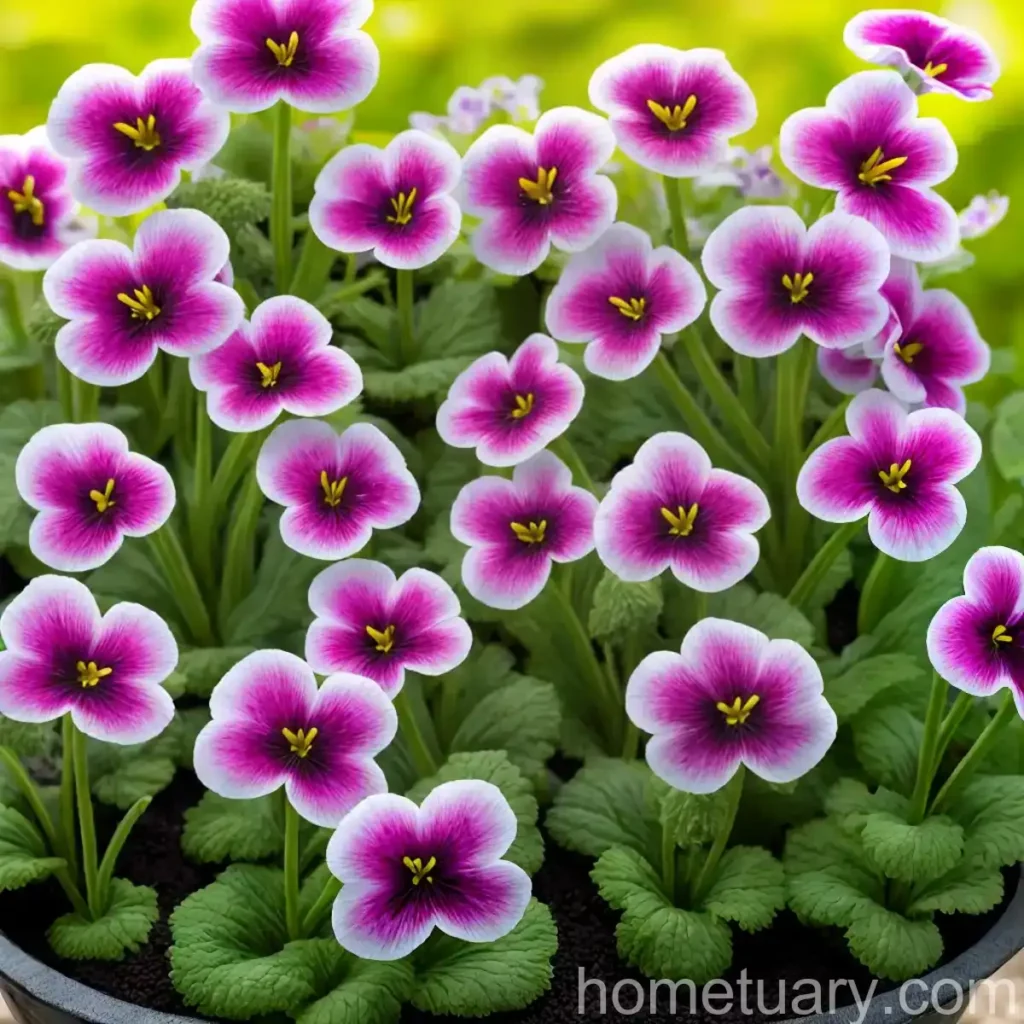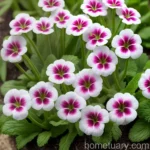The Brilliant Primula ‘Wanda Kay’
What is Plant Primula (Primula ‘Wanda Kay’)?
Primula (Primula ‘Wanda Kay’), commonly known as Wanda Kay primrose, is an adorable and vibrant perennial plant popular for its striking clusters of colorful blooms. This hybrid primrose is part of the Primula genus, which consists of over 400 species of herbaceous flowering plants. ‘Wanda Kay’ is an exquisite and cherished variety that is prized for its profusion of blossoms, making it a beloved choice for both indoor and outdoor settings. With its stunning visual appeal and versatility in various gardening styles, the Primula ‘Wanda Kay’ adds a touch of elegance to any landscape.
This blog post will explore the mesmerizing world of Primula ‘Wanda Kay,’ delving into its care routines, cultural background, uses, and much more, offering a comprehensive guide for enthusiasts seeking to nurture and appreciate this renowned floral beauty.
Key Takeaways – Primula (Primula ‘Wanda Kay’)
- Scientific Name: Primula ‘Wanda Kay’
- Common Name: Wanda Kay Primrose
- Watering: Requires regular watering to keep the soil consistently moist.
- Sunlight: Thrives in partial shade or filtered sunlight.
- Fertilization: Beneficial to provide a balanced fertilizer during the growing season.
- Soil: Flourishes in well-drained, humus-rich soil.
- Pruning: Regular deadheading of spent flowers promotes continuous blooming.
- Propagation: Easily propagated through division in early spring or after flowering.
- Container Popularity: Ideal for container gardening.
- Common Diseases: Susceptible to fungal diseases such as powdery mildew and root rot.
- Common Pests: Vulnerable to attacks from aphids and slugs.
- Fun Facts: The Primula ‘Wanda Kay’ is a delightful companion plant and attracts pollinators.
Culture
Uses
The Primula ‘Wanda Kay’ is a versatile plant that can be utilized in diverse ways to enhance the visual appeal of gardens, landscapes, and indoor spaces. Some popular uses include:
- Bedding Displays
- Edging for Borders
- Container Gardening
- Rock Gardens
- Shade Gardens
- Mixed Plantings
- Cottage Gardens
- Woodland Gardens
- Landscaping
- Indoor Plant Decor
The vibrant blooming display of the Wanda Kay Primrose makes it a coveted choice for various gardening and landscaping applications, adding a burst of color and charm to any setting.
Water
Adequate and timely watering is essential for the lush growth and prolific flowering of Primula ‘Wanda Kay.’ Since these plants prefer consistently moist soil, it is crucial to monitor the moisture levels and water as needed. Overly dry conditions can lead to wilting and reduced flower production, so regular watering is vital, particularly during dry spells or hot weather.
Sunlight
Primula ‘Wanda Kay’ thrives in partial shade with filtered sunlight, making it an excellent choice for shaded spots in the garden. While it appreciates some sun, especially in cooler climates, it generally prefers to be shielded from direct, scorching sun rays. Well-suited for dappled light or areas with morning sun and afternoon shade, this primrose variety can also thrive indoors in bright, indirect light conditions.
Fertilizer
To encourage healthy growth and abundant flowering, the application of a balanced fertilizer is beneficial for Primula ‘Wanda Kay.’ During the growing season, a slow-release or diluted liquid fertilizer can be applied according to the manufacturer’s instructions. However, it is essential to avoid excessive fertilization, especially with high-nitrogen formulations, as this may lead to soft growth and compromise the plant’s overall vigor.
Soil
The Wanda Kay Primrose flourishes in well-drained, humus-rich soil that provides the ideal growing environment for its roots. A balanced mix of organic matter, such as compost or leaf mold, can significantly enhance the soil structure and fertility, promoting robust growth and vibrant blooms. Additionally, a slightly acidic to neutral pH level is preferred, ensuring optimal nutrient uptake and overall plant health.
Pruning
Pruning and deadheading are integral components of maintaining the Primula ‘Wanda Kay’ to promote continuous flowering and a tidy appearance. Regular removal of spent flowers not only encourages the development of new blooms but also prevents the plant from expending energy on seed production, thereby prolonging the flowering period. Care should be taken to trim away any damaged or yellowing foliage to maintain the plant’s vigor and aesthetic appeal.
Propagation
Propagating Primula ‘Wanda Kay’ is relatively straightforward and can be accomplished through division, primarily in early spring or after the flowering season. By carefully separating the plant into smaller sections, each containing healthy roots and shoots, new individuals can be established and transplanted to desired locations. This method allows for the expansion of existing plantings and is an excellent way to share the beauty of Wanda Kay Primroses with fellow gardening enthusiasts.
Container Popularity
The compact and colorful nature of Primula ‘Wanda Kay’ makes it exceptionally well-suited for container gardening. Whether showcased individually in decorative pots or incorporated into mixed plantings, these primroses add a delightful touch to patios, balconies, and outdoor living spaces. The versatility of container cultivation enables plant enthusiasts to create captivating displays and elevate their surroundings with the vibrant allure of Wanda Kay Primroses.
Common Diseases
Despite its charm and resilience, Primula ‘Wanda Kay’ is susceptible to certain diseases, particularly those associated with fungal pathogens. Understanding these potential ailments and employing preventive measures can help safeguard the plant’s health and vitality.
Disease Diagnosis
Powdery Mildew
Powdery mildew, characterized by the presence of powdery white patches on the foliage, is a common fungal disease that can affect Primula ‘Wanda Kay.’ This condition arises under humid conditions and may result in leaf distortion and reduced vigor. Proper air circulation and the application of appropriate fungicidal treatments can help mitigate the impact of powdery mildew.
Root Rot
Excessive soil moisture or poorly drained conditions can lead to root rot, a detrimental fungal disease that affects the root system of plants. Symptoms may include wilting, stunted growth, and yellowing of the foliage. To prevent root rot, ensuring proper drainage and avoiding waterlogged soil are crucial precautions to safeguard the health of the Primula ‘Wanda Kay.’
Common Pests
In addition to fungal diseases, the Wanda Kay Primrose may also fall prey to certain pests that can compromise its well-being and visual appeal.
Aphids
Aphids are among the most common pests that can infest Primula ‘Wanda Kay,’ feeding on the succulent plant tissues and secreting a sticky substance known as honeydew. Regular monitoring and the use of insecticidal soaps or horticultural oils can aid in controlling aphid populations and minimizing damage to the plant.
Slugs and Snails
These voracious feeders can cause unsightly damage to the foliage of the Primula ‘Wanda Kay,’ particularly in moist and shady environments. Employing effective slug and snail deterrents, such as beer traps or copper barriers, can help protect the plant from these persistent garden pests.
Botanist’s Tips
Soil Preferences
Selecting well-draining, moisture-retentive soil with a slightly acidic to neutral pH is essential for promoting the vigorous growth and abundant flowering of Primula ‘Wanda Kay.’ Incorporating organic amendments, such as compost or peat moss, can contribute to an optimal growing medium that supports the plant’s overall well-being.
Watering Guidelines
Maintaining consistent soil moisture through regular watering is vital for the sustained health and vitality of the Wanda Kay Primrose. It is crucial to strike a balance, as overly saturated conditions can lead to root rot, while extended periods of drought may result in stress and diminished flowering. Monitoring the soil’s moisture levels and adjusting the watering frequency accordingly is key to ensuring an optimal growing environment for the plant.
Companion Planting
The vibrant blooms and compact habit of Primula ‘Wanda Kay’ make it an excellent companion plant for various garden favorites, enhancing the visual appeal and diversity of plantings. When pairing Wanda Kay Primroses with other compatible species, consider factors such as color schemes, height differentials, and soil preferences to create harmonious and visually engaging combinations.
Fun Facts
- The Primula ‘Wanda Kay’ is a favored choice for attracting pollinators, contributing to the biodiversity and ecological balance of the garden.
- This delightful primrose variety is an ideal selection for adding a splash of color to shaded areas, infusing dull spots with vibrant blooms and visual charm.
- With proper care and maintenance, Primula ‘Wanda Kay’ can provide a prolonged flowering display, captivating onlookers with its enduring beauty.
Links to External Resources
To further expand your knowledge and appreciation of Primula ‘Wanda Kay,’ consider exploring the following external resources:
- Royal Horticultural Society: Primula Care Guide
- The National Gardening Association: Growing Primroses
- University of Wisconsin-Madison Extension: Common Diseases of Primula
- North Carolina State University Extension: Controlling Aphids
Conclusion
In summary, the captivating Primula ‘Wanda Kay’ enthralls plant enthusiasts with its profusion of colorful blooms, adaptability to diverse settings, and overall visual allure. By adhering to its specific cultural requirements, exercising preventive measures against common diseases and pests, and leveraging the invaluable insights provided by botanists and horticultural experts, individuals can cultivate and savor the exquisite beauty of this beloved primrose variety.
Armed with the comprehensive information and actionable tips presented in this guide, gardening enthusiasts are well-equipped to embark on a rewarding journey of nurturing and appreciating the remarkable Primula ‘Wanda Kay,’ elevating their outdoor and indoor spaces with its enchanting presence.















